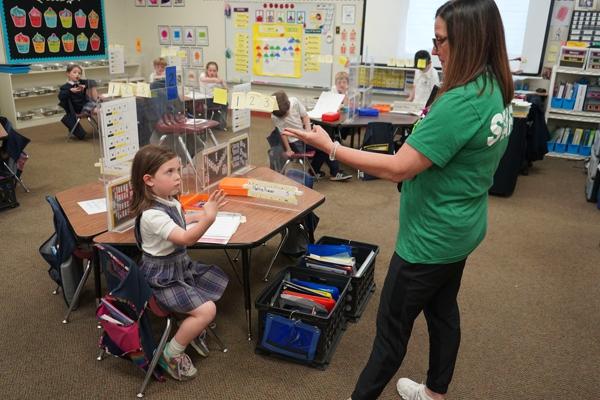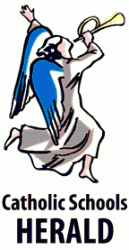

When Immaculate Conception kindergarten teacher Kim Wine asked her students to journal about either Holy Week or “Wacky Weather Wednesday” April 13, as stormy weather raged outside, she had a few instructions first.
“First thing you need to do is think about it. Count your words. Feel the sentence. Write the sentence,” she said, as students repeated each phrase, holding up fingers and moving their arms.
“Am I going to help you spell a word?” Wine asked.
“No,” the kids replied.
In truth, Wine did not need to help them spell a word. They already had tools, like small “sound wall” images at their desk, with letters displayed next to pictures that matched the sounds. But Wine was ready to guide them if needed.
“It is cloudy today,” student Hattie Fraser, 5, read slowly from her journal after referencing her sound wall to figure out how to spell the words.
Wine’s class at the North Little Rock school is one of many throughout the state learning to read with the Science of Reading initiative that prioritizes reading components like phonological awareness over memorization.
According to the National Assessment of Educational Progress (NAEP) data, for decades, less than half of students in the United States read at grade level. According to 2019 NAEP statistics for Arkansas, only 31 percent of both fourth- and eighth-grade students were proficient in reading.
The COVID-19 pandemic exasperated the problem. A March 8 New York Times article cited several new studies on the educational impacts of the pandemic that point to a third of children in the early grades missing reading benchmarks, a significant uptick from pre-pandemic statistics. Years of data and research have led educators to the Science of Reading.
About 50 Catholic school kindergarten through second-grade teachers in Arkansas were trained last summer to implement the initiative in their classrooms led by Catholic school educators Ashley Davis and Nichole Schafer. It’s not a program, but a new way of approaching the most vital part of a student’s education — learning how to read.
“Research shows our brain is not wired to learn to read,” said Davis, assistant principal for St. Vincent de Paul School in Rogers.
Davis explained there are several pathways used in breaking down each skill to learn to read throughout different quadrants of the brain.
The diocesan Catholic Schools Office has been impressed with what they have seen so far.
“If I was comparing it to doing math, and let’s say you’re doing long division. You can’t do long division if you don’t know how to multiply and subtract,” said superintendent Theresa Hall. “So it’s like, you get all the parts together, as scientifically based on how you should be learning how to read.”
According to the state’s Department of Education, public school teachers must be proficient in the training, whereas private school teachers only need an “awareness.” Free “awareness” level training is available online, like ArkansasIDEAS, but Hall admits they are not “near as engaging.”
Thanks to discussions Davis had with the Department of Education, she was able to start a summer course in 2019, along with Schafer, assistant principal at Immaculate Conception School in North Little Rock. The training lasted about a year and a half, with 18 total days of learning. Catholic school teachers can also get training with their local school co-op, if available.
“What we’re getting with Nicole and Ashley training is really how you can take this and teach it to the student, teach this way. It’s just so much more useful in the classroom,” Hall said.
The in-person, six-day training with Davis and Schafer costs $150 a teacher, which covers the cost of materials. The initiative will expand this summer, with third through sixth-grade teachers eligible to be trained. Hall said all private school teachers must have awareness training with the Science of Reading by 2024, per the state, for their recertification.
According to the Arkansas Department of Education’s R.I.S.E. Arkansas Science of Reading Resources website, the Science of Reading focuses on providing five key areas of instruction:
When these four areas are achieved, comprehension is the final step. The goal is to make sure students are proficient in reading and lessen the gaps as they move through the grades.
“I think we will see less reading problems within our school if teachers use this and teach this way,” Hall said.
It is taught with targeted activities and the assistance of proven programs that follow these four areas.
The style is a multi-sensory approach, Davis said, “They have to be doing more than just hearing it, and use their body to make it stick.”
She explained that in kindergarten, students could say the letter “A” out loud and say the sounds it makes, all while tracing the letter in a tray of sand.
“It’s auditory; you’re using your hands while doing it. Speaking, hearing it and using your body, crossing into different pathways in your brain,” Davis said.
Lorena Mariscotti, who taught 10 years in her native Argentina, two in Montessori education in London and the past six years at St. Vincent de Paul in Rogers, said she’s “shocked how the kids have grown throughout the year” with the Science of Reading.
Using the Heggerty program, Mariscotti said it’s a step-by-step approach that breaks down what parts of language students need to learn each day throughout the more than 30 weeks of the plan.
“You start with basics — ‘Say bookcase but don’t say book,’” breaking down a sound and deleting sounds and also manipulating words, Mariscotti said, like “‘Say ‘Stop,’ but change ‘St’ to ‘Cr’ — Crop.”
It also uses techniques like counting words in a sentence, clapping for each word or syllable and, saying the words out loud with their eyes closed or raising their hands, using “muscle power when sounding out the word. So every sound they hear within the word, they put their arm up,” Mariscotti said.
“We are not born for reading, so what you are basically doing is mapping the brain into being able to read. I think that’s what makes a difference because it comes so automatically,” Mariscotti said.
Wine, a teacher for more than 20 years, said, “back in the olden days,” it was common for teachers to have word walls, with words added to a poster as students would memorize them. Now Wine has a sound wall.
“Our brains are wired not necessarily to learn words but to hear vocabulary and sounds. That’s how we teach and use the sound wall. It has pictures on it and pictures of letters and sounds. It’s a great learning tool,” Wine said, adding that one part of the wall includes a “Vowel Valley,” depicting short vowel sounds. “If they’re trying to decode the word cat, they’ll start sounding out the individual sounds. They might know the ‘Ca’ is C, and they’ll say, ‘What makes the ‘Aa’ sound?’ And we’ll find a picture of the apple. Because they know apple has the same sound. So they’ll go back and write an ‘A.’”
It’s the second year Wine has used the Science of Reading in her classroom, and the impacts have been drastic.
“They’re not scared to write or scared to read,” she said. “Which is very, very exciting because that’s not always been the case. That confidence it instills in those kids, it’s very impressive.”
Hall said the Catholic Schools Office would look at the standards for both curriculum and kindergarten report cards to make sure Science of Reading is a part of that structure.
Schafer, who was a literacy coach for the North Little Rock School District for eight years, said if a student struggles in reading, Science of Reading has targeted assessments that determine which of the four areas a student needs extra assistance. That alone can change the trajectory of a student’s life, as reading “affects everything, and their ability to continue learning,” Schafer said.
“One of the things we will do in our training is help teach the teachers what to do when they get a child in their class that’s struggling in some way. The other part of that is they’re not all special-ed kids,” Schafer said. “Long gone are the days of ‘Oh, they can’t read. I’m going to call the resource teacher and have an evaluation done and have them go to special ed class.’ We have to empower the teachers to help the kids in the classroom.”
Please read our Comments Policy before posting.
Article comments powered by Disqus Catholic school coaches: Best of friends and of rivals
Catholic school coaches: Best of friends and of rivals
 St. Vincent de Paul School breaks ground on expansion
St. Vincent de Paul School breaks ground on expansion
 Catholic school careers lead teachers, staff into faith
Catholic school careers lead teachers, staff into faith
 Catholic scholarship appeal closing aid gap
Catholic scholarship appeal closing aid gap
 Arkansas Catholic schools see most students in 5 years
Arkansas Catholic schools see most students in 5 years
 Studio 3:16 offers new approach to teaching religion
Studio 3:16 offers new approach to teaching religion
 After three decades, NLR principal plans to retire
After three decades, NLR principal plans to retire
 CHS athlete overcomes odds to reach collegiate goal
CHS athlete overcomes odds to reach collegiate goal
 John Calipari: UA basketball coach and devout Catholic
John Calipari: UA basketball coach and devout Catholic
 'Cabrini' film tells story of saint with great faith
'Cabrini' film tells story of saint with great faith
 St. Joseph a model of solidarity with immigrants
St. Joseph a model of solidarity with immigrants
 Two gifts after Jesus’ death: Virgin Mary and Eucharist
Two gifts after Jesus’ death: Virgin Mary and Eucharist
 Why we have an altar, and not just a communion table
Why we have an altar, and not just a communion table
 Pope: Wars should be resolved through nonviolence
Pope: Wars should be resolved through nonviolence
 Living relationship with Jesus Christ in the Eucharist
Living relationship with Jesus Christ in the Eucharist